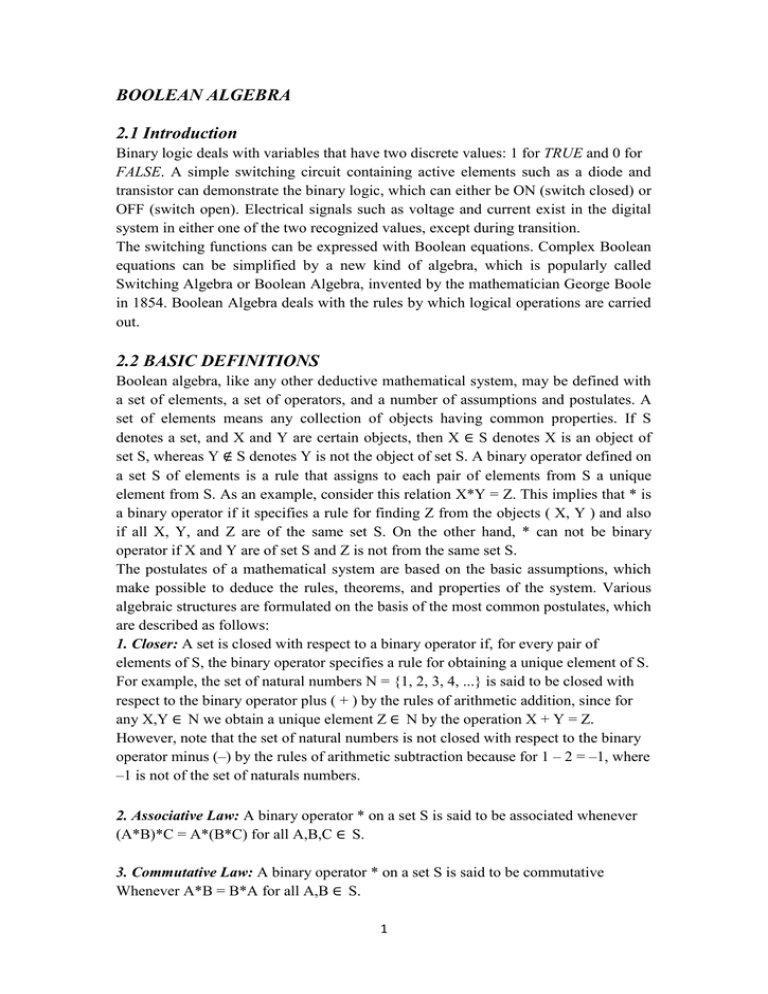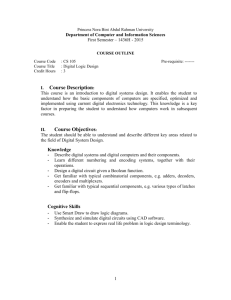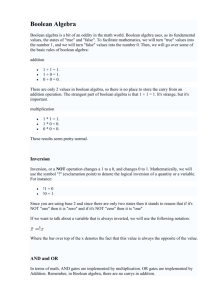BOOLEAN ALGEBRA 2.1 Introduction
advertisement

BOOLEAN ALGEBRA
2.1 Introduction
Binary logic deals with variables that have two discrete values: 1 for TRUE and 0 for
FALSE. A simple switching circuit containing active elements such as a diode and
transistor can demonstrate the binary logic, which can either be ON (switch closed) or
OFF (switch open). Electrical signals such as voltage and current exist in the digital
system in either one of the two recognized values, except during transition.
The switching functions can be expressed with Boolean equations. Complex Boolean
equations can be simplified by a new kind of algebra, which is popularly called
Switching Algebra or Boolean Algebra, invented by the mathematician George Boole
in 1854. Boolean Algebra deals with the rules by which logical operations are carried
out.
2.2 BASIC DEFINITIONS
Boolean algebra, like any other deductive mathematical system, may be defined with
a set of elements, a set of operators, and a number of assumptions and postulates. A
set of elements means any collection of objects having common properties. If S
denotes a set, and X and Y are certain objects, then X ∈ S denotes X is an object of
set S, whereas Y ∉ S denotes Y is not the object of set S. A binary operator defined on
a set S of elements is a rule that assigns to each pair of elements from S a unique
element from S. As an example, consider this relation X*Y = Z. This implies that * is
a binary operator if it specifies a rule for finding Z from the objects ( X, Y ) and also
if all X, Y, and Z are of the same set S. On the other hand, * can not be binary
operator if X and Y are of set S and Z is not from the same set S.
The postulates of a mathematical system are based on the basic assumptions, which
make possible to deduce the rules, theorems, and properties of the system. Various
algebraic structures are formulated on the basis of the most common postulates, which
are described as follows:
1. Closer: A set is closed with respect to a binary operator if, for every pair of
elements of S, the binary operator specifies a rule for obtaining a unique element of S.
For example, the set of natural numbers N = {1, 2, 3, 4, ...} is said to be closed with
respect to the binary operator plus ( + ) by the rules of arithmetic addition, since for
any X,Y ∈ N we obtain a unique element Z ∈ N by the operation X + Y = Z.
However, note that the set of natural numbers is not closed with respect to the binary
operator minus (–) by the rules of arithmetic subtraction because for 1 – 2 = –1, where
–1 is not of the set of naturals numbers.
2. Associative Law: A binary operator * on a set S is said to be associated whenever
(A*B)*C = A*(B*C) for all A,B,C ∈ S.
3. Commutative Law: A binary operator * on a set S is said to be commutative
Whenever A*B = B*A for all A,B ∈ S.
1
4. Identity Element: A set S is to have an identity element with respect to a binary
operation * on S, if there exists an element E ∈ S with the property E*A = A*E = A.
Example: The element 0 is an identity element with respect to the binary operator +
on the set of integers I = {.... –4, –3, –2, –1, 0, 1, 2, 3, 4, ....} as
A + 0 = 0 + A = A.
Similarly, the element 1 is the identity element with respect to the binary operator ×
as A × 1 = 1 × A = A.
5. Inverse: If a set S has the identity element E with respect to a binary operator *,
there exists an element B ∈ S, which is called the inverse, for every A ∈ S, such that
A*B = E.
Example: In the set of integers I with E = 0, the inverse of an element A is (-A) since
A + (–A) = 0.
6. Distributive Law: If * and (.) are two binary operators on a set S, * is said to be
distributive over (.), whenever
A*(B.C) = (A*B).(A*C).
If summarized, for the field of real numbers, the operators and postulates have the
following meanings:
The binary operator + defines addition.
The additive identity is 0.
The additive inverse defines subtraction.
The binary operator (.) defines multiplication.
The multiplication identity is 1.
The multiplication inverse of A is 1/A, defines division i.e., A. 1/A = 1.
The only distributive law applicable is that of (.) over +
A . (B + C) = (A . B) + (A . C)
2.3 DEFINITION OF BOOLEAN ALGEBRA
In 1854 George Boole introduced a systematic approach of logic and developed an
algebraic system to treat the logic functions, which is now called Boolean algebra. In
1938 C.E. Shannon developed a two-valued Boolean algebra called Switching
algebra, and demonstrated that the properties of two-valued or bistable electrical
switching circuits can be represented by this algebra. The postulates formulated by
E.V. Huntington in 1904 are employed for the formal definition of Boolean algebra.
However, Huntington postulates are not unique for defining Boolean algebra and
other postulates are also used. The following Huntington postulates are satisfied for
the definition of Boolean algebra on a set of elements S together with two binary
operators (+) and (.).
1. (a) Closer with respect to the operator (+).
(b) Closer with respect to the operator (.).
2. (a) An identity element with respect to + is designated by 0 i.e., A + 0 = 0 + A = A.
2
(b) An identity element with respect to . is designated by 1 i.e., A.1 = 1. A = A.
3. (a) Commutative with respect to (+), i.e., A + B = B + A.
(b) Commutative with respect to (.), i.e., A.B = B.A.
4. (a) (.) is distributive over (+), i.e., A . (B+C) = (A . B) + (A . C).
(b) (+) is distributive over (.), i.e., A + (B .C) = (A + B) . (A + C).
5. For every element A ∈ S, there exists an element A' ∈ S (called the complement of
A) such that A + A′ = 1 and A . A′ = 0.
6. There exists at least two elements A,B ∈ S, such that A is not equal to B.
Comparing Boolean algebra with arithmetic and ordinary algebra (the field of real
numbers), the following differences are observed:
1. Huntington postulates do not include the associate law. However, Boolean algebra
follows the law and can be derived from the other postulates for both operations.
2. The distributive law of (+) over ( . ) i.e., A+ (B.C) = (A+B) . (A+C) is valid for
Boolean algebra, but not for ordinary algebra.
3. Boolean algebra does not have additive or multiplicative inverses, so there are no
subtraction or division operations.
4. Postulate 5 defines an operator called Complement, which is not available in
ordinary algebra.
5. Ordinary algebra deals with real numbers, which consist of an infinite set of
elements. Boolean algebra deals with the as yet undefined set of elements S, but in the
two valued Boolean algebra, the set S consists of only two elements: 0 and 1.
Boolean algebra is very much similar to ordinary algebra in some respects. The
symbols (+) and (.) are chosen intentionally to facilitate Boolean algebraic
manipulations by persons already familiar to ordinary algebra. Although one can use
some knowledge from ordinary algebra to deal with Boolean algebra, beginners must
be careful not to substitute the rules of ordinary algebra where they are not applicable.
2.4 TWO-VALUED BOOLEAN ALGEBRA
Two-valued Boolean algebra is defined on a set of only two elements, S = {0,1}, with
rules for two binary operators (+) and (.) and inversion or complement as shown in
the following operator tables at Figures 2.1, 2.2, and 2.3 respectively.
Figure 2-1
Figure 2-2
The rule for the complement operator is for verification of postulate 5.
3
Figure 2-3
These rules are exactly the same for as the logical OR, AND, and NOT operations,
respectively. It can be shown that the Huntington postulates are applicable for the set
S = {0,1} and the two binary operators defined above.
1. Closure is obviously valid, as form the table it is observed that the result of each
operation is either 0 or 1 and 0,1 ∈ S.
2. From the tables, we can see that:
(i) 0 + 0 = 0 0 + 1 = 1 + 0 = 1
(ii) 1 . 1 = 1 0 . 1 = 1 . 0 = 0
which verifies the two identity elements 0 for (+) and 1 for (.) as defined by postulate
2.
3. The commutative laws are confirmed by the symmetry of binary operator tables.
4. The distributive laws of (.) over (+) i.e., A . (B+C) = (A . B) + (A . C), and (+) over
(.) i.e., A + ( B . C) = (A+B) . (A+C) can be shown to be applicable with the help of
the truth tables considering all the possible values of A, B, and C as under.
From the complement table it can be observed that:
(a) Operator (.) over (+)
A
B
C
B+C
A.(B+C)
A.B
A.C
(A.B)+(A.C)
0
0
0
0
0
0
0
0
0
0
1
1
0
0
0
0
0
1
0
1
0
0
0
0
0
1
1
1
0
0
0
0
1
0
0
0
0
0
0
0
1
0
1
1
1
0
1
1
1
1
0
1
1
1
0
1
1
1
1
1
1
1
1
1
Figure 2-4
(b)
A
0
0
0
0
1
1
1
1
Operator (+) over (.)
B
C
B.C
A+(B.C)
0
0
0
0
0
1
0
0
1
0
0
0
1
1
1
1
0
0
0
1
0
1
0
1
1
0
0
1
1
1
1
1
A+B
0
0
1
1
1
1
1
1
A+C
0
1
0
1
1
1
1
1
(A+B).(A+C)
0
0
0
1
1
1
1
1
Figure 2-5
(c) A + A′ = 1, since 0 + 0' = 1 and 1 + 1' = 1.
(d) A . A′ = 0, since 0 . 0' = 0 and 1 . 1' = 0.
These confirm postulate 5.
5. Postulate 6 also satisfies two-valued Boolean algebra that has two distinct elements
0 and 1 where 0 is not equal to 1.
4
2.5 BASIC PROPERTIES AND THEOREMS OF BOOLEAN
ALGEBRA
2.5.1 DeMorgan's Theorem
Two theorems that were proposed by DeMorgan play important parts in Boolean
algebra.
The first theorem states that the complement of a product is equal to the sum of the
complements. That is, if the variables are A and B, then:
(A.B)′ = A′ + B′
The second theorem states that the complement of a sum is equal to the product of the
complements. In equation form, this can be expressed as:
(A + B)′ = A′ . B′
The complements of Boolean logic function or a logic expression may be simplified
or expanded by the following steps of DeMorgan’s theorem.
(a) Replace the operator (+) with (.) and (.) with (+) given in the expression.
(b) Complement each of the terms or variables in the expression.
DeMorgan’s theorems are applicable to any number of variables. For three variables
A, B, and C, the equations are:
(A.B.C)′ = A′ + B′ + C′ and
(A + B + C)′ = A′.B′.C′
The following is the complete list of postulates and theorems useful for two-valued
Boolean algebra.
Figure 2-6
5

